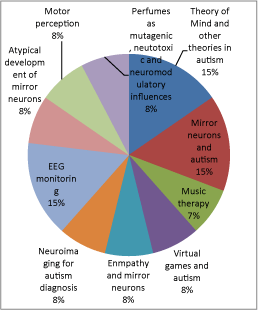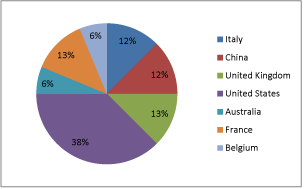
Mini Review
Austin J Autism & Relat Disabil. 2016; 2(1): 1011.
The Role of Mirror Neurons in Autism Spectrum Disorder
Guedes Neta ML* and Varanda CA
Instituto de Ciências Humanas, Universidade Paulista, Brazil
*Corresponding author: Guedes Neta, ML, Av: Moura Ribeiro, n° 125/ 178 – Marapé – Santos – SP – CEP 11070-061, Brazil
Received: October 11, 2015; Accepted: January 13, 2016; Published: January 20, 2016
Abstract
The objective of this scientific research was to review studies investigating whether mirror neurons were or were not impaired in ASD individuals. Currently, these neurons have proved to be responsible for empathy. In other words, they would be responsible for our ability to put ourselves in someone else’s position.
This innate human ability is impaired in ASD. Consequently, a question comes up: is empathy impairment in ASD individuals caused by impaired mirror neurons?
Among 17 studies reviewed here most of them see the hypothesis of impaired mirror neurons in autism as promising.
Given the relevance of these findings, it is essential to consider the importance of investing in this area and developing research that is more detailed. This leads us to question whether activities that stimulate empathy would contribute to a better brain functioning in individuals with autism in order to improve reciprocal social development.
Keywords: Autism; Mirror neurons; Empathy; Brain
Abbreviations
ASD: Autism Spectrum Disorder; IBGE: Instituto Brasileiro De Geografia e Estatísticas (The Brazilian Institute of Geography and Statistics); DSM-5: Diagnostic and Statistical Manual of Mental Disorders.
Introduction
Autism and mirror neurons
Autism is seen as a heterogeneous neurodevelopmental disorder which affects one in 165 children and is four times more incident in boys than in girls [1]. According to the DSM-5, the main criteria for diagnosing autism are: persistent damage to the reciprocal social communication and to the social interaction (such as imitation and empathy); restrict and repetitive behavioral patterns, interests or activities. The symptoms are also evident in the early childhood and limit or impair daily life [2].
In the 80’s, the first studies in autistic patients making use of magnetic resonance were carried out [3]. The 90’s were considered the brain decade, as most studies about the human brain were undertaken during this period. Rizzolati et al. accidentally discovered the existence of mirror neurons [4]. These researchers were studying electrical signals of a certain kind of motor neuron in monkeys, and realized, accidentally, that their motor neuron discharged not only when they performed and action, but also when they saw another monkey or one of the researchers performing the same action [5].
Ramachandran states that these neurons are essential to the human being because they can deduct intentions [6]. According to him, these neurons enable the imitation of other people’s actions and, therefore, are seen as the “empathy neurons”. This author defends that this discovery represents to Psychology what the discovery of the DNA represented to Biology [7].
According to Williams, impairment of the mirror neuron system can affect imitation, producing a constellation of symptoms which characterize ASD [8].
The studies carried out to confirm or not this hypothesis were based in functional magnetic resonance imaging studies [1,9], that is a technique for measuring brain activity and electroencephalography study monitoring activity of the brain [10,11]. In most of these studies the neurons of the ASD individuals and control groups were monitored while they observed the action of another person.
The proposal of this review was, therefore, to go through recent neuroscientific studies about this group of neurons and its connection to autism since it intrigues researchers and neuroscientists all around the world.
Initially, our objective was to analyze articles in English and Portuguese published between 2008 and 2013 in the SciELO and LILACS databases. However, there were no articles in Portuguese connected to the theme. Thus, the review was developed based only in texts in English. Out of the 17 articles found, 5 were experimental studies [1,9-12] and 12 were bibliographical reviews [4,8,13-22].
Results
The articles found presented different themes as shown in (Figure 1).

Figure 1: Themes covered in the 17 articles.
Analyzing the articles, 76% of them were favorable to the participation of mirror neurons in autism [1,4,8,12-22] and 24% were not [9-11,16,20].
The analysis investigated the countries where the articles were published. Figure 2 shows that even though these articles came from various countries, most of them had North-American authors, which indicates that in this country there are more advances in the investigation of the role of mirror neurons in cases of autism compared to other countries. (Figure 2).

Figure 2: List of countries where the articles were published.
Conclusion
Based on the fact that not even one article was found in Portuguese, it is possible to conclude that research about the role of mirror neurons in the Brazilian scientific community is still incipient. According to the latest IBGE data (2010), the Brazilian population outnumbers 190 million people [23]. Among them, 0.3% is diagnosed as having ASD, which means approximately 570 thousand people [24]. This relevant figure points out to the urgent need to develop studies concerning autism, particularly relating mirror neurons to ASD.
This study has demonstrated that, despite the divergence of findings among different research groups, there is a tendency to confirm the hypothesis that an impaired mirror neuron system is associated to the incidence of ASD.
It is evident that investments in advanced technology researches can lead to extremely socially relevant discoveries, as they could help professionals and caretakers who deal with and/or live with ASD individuals.
Acknowledgement
The first author thanks National Council of Technological and Scientific Development (Conselho Nacional de Desenvolvimento Científico e Tecnológico) for funding a research scholarship.
References
- Martineau J, Andersson F, Barthelemy C, Cottier JP, Destrieux C. Atypical activation of the mirror neuron system during perception of hand motion in autism. Brain Res. 2010; 1320: 168-175.
- APA. Manual diagnóstico e estatístico de transtornos mentais: DSM-5. 5a ed. Porto Alegre: Artmed, 2014.
- Kandel ER, Schwartz JH, Jessell TM, Siegelbauml SA. Princípios de neurociências. 5a ed. Porto Alegre: Artmed. 2014.
- Rizzolatti G, Fabbri-Destro M. Mirror neurons: from discovery to autism. Exp Brain Res. 2010; 200: 223-237.
- Lent R. Sobre neurônios, cérebros e pessoas. São Paulo: Atheneu, 2011.
- Ramachandran VS. O que o cérebro tem para contar. Rio de Janeiro: Zahar, 2014.
- Peres J. Trauma e Superação. O que a psicologia, a neurociência e a espiritualidade ensinam. São Paulo: Roca, 2009.
- Williams JHG. Self-Other Relations in Social Development and Autism: Multiple Roles for Mirror Neurons and Other Brain Bases. Autism Research. 2008; 1: 73-90.
- Dinstein I, Thomas C, Humphreys K, Minshew N, Behrmann M, Heeger DJ. Normal movement-selectivity in autism. Neuron. 2010; 66: 461-469.
- Raymaekers R, Wiersema JR, Roeyers H. EEG study of the mirror neurons system in children with high functioning autism. Brain Research. 2009; 1304: 113-121.
- Bernier R, Aaronson B, McPartland J. The role of imitation in the observed heterogeneity in EEG mu rhythm in autism and typical development. Brain and Cognition. 2013; 82: 69-75.
- Bagarsa O, Golkar Z, Garcia M, Rice LN, Pace DG. Role of perfumes in pathogenesis of Autism. Medical Hypotheses. 2013; 80: 795-803.
- Buccino G, Amore M. Mirror neurons and the understanding of behavioural symptoms in psychiatric disorders. Curr Opin Psychiatry. 2008; 21: 281-285.
- Chein W, Yuan TF. Mirror neuron system as the joint from action to language. Neurosci Bull. 2008; 24: 259-264.
- Le Bel RM, Pineda JA, Sharma A. Motor-auditory-visual integration: The role of human mirror neuron system in communication and communication disorders. J Commun Disord. 2009; 42: 299-304.
- Hamilton AFC. Goals, intentions and mental states: challenges for theories of autism. Journal of Child Psychology and Psychiatry. 2009; 50: 881-892.
- Wan CY, Demaine K. Zipse L, Norton A, Schlaug G. From music making to speaking: Engaging the mirror neuron system in autism. Brain Res Bull. 2010; 82: 161-168.
- Kana RK, Wadsworth HM, Travers BG. A systems level analysis of the mirror neuron hypothesis and imitation impairments in autism spectrum disorders. Neuroscience and Biobehavioral Reviews. 2011; 35: 894-902.
- Zhu H, Sun Y, Zeng J, Sun H. Mirror neural training induced by virtual reality in brain-computer interfaces may provide a promising approach for the autism therapy. Medical Hypotheses. 2011; 76: 646-647.
- Baird AD, Scheffer IE, Wilson SJ. Mirror neuron system involvement in empathy: A critical look at the evidence. Social Neuroscience. 2011; 6: 327-335.
- Lauvin MA, Martineau J, Destrieux C, Andersson F, Bonnet-Brillhault FM. Gomot, et al. Functional morphological imaging of autism spectrum disorders: Current position and theories proposed. Diagnostic and Interventional Imaging. 2012; 93: 139-147.
- Fisch GS. Autism and Epistemology IV: Does Autism Need a Theory of Mind? Am J Med Genet Part A. 2013; 161A: 2464-2480.
- Instituto Brasileiro de Geografia e Estatística (IBGE).
- Paula CS, Ribeiro SH, Fombonne E, Mercadante MT. Brief Report: Prevalence of Pervasive Developmental Disorder in Brazil: A pilot study. J Autism Dev Disord. 2011; 41: 1738-1742.